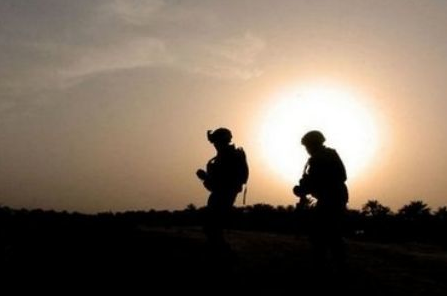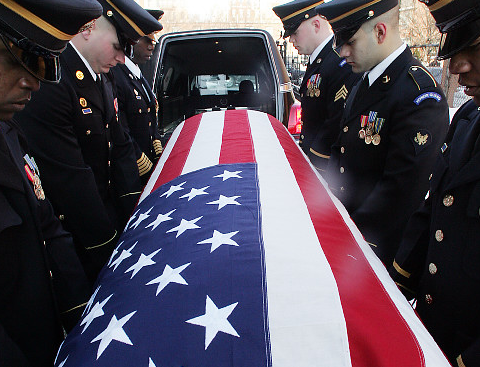No soldier wants to be the last casualty in a war, but surely that designation pales in comparison to being the first fatal casualty in a combat mission that has already been declared “over.” One week after “turning the page” on Operation Freedom, two unidentified U.S. soldiers were killed by Iraqi soldiers in a firefight inside an Iraqi Army base north of Baghdad. This would be the same Iraqi army that 50,000 U.S. military personnel were left behind (after the page was “turned”) to “advise and train.” It would be comedic if it wasn’t so tragic, but even these theatrical characterizations fail to capture the sheer absurdity of the situation: soldiers fighting a war of foreign occupation/liberation that was initiated under false or grossly mistaken pretenses, and subsequently attacked and killed by the “security forces” they were assigned to help once the war was declared “over.”
The photograph above, which accompanied one of the early stories reporting on the incident, calls attention to the irrationality of the ordeal. The soldiers here, of course, are alive, cast in silhouette against what is either a setting or a rising sun. The incongruity of featuring a photograph of two unidentifiable soldiers that live and breathe in a story about two unidentified fatalities marks the event being reported as somewhat farcical, almost as if to challenge the very possibility of representing soldiers dying in a war that has been declared over. But of course, all appearances and declarations aside, the war isn’t over, a point underscored by the ambiguous register of the blazing hot sun. It is important in this regard to notice that there is nothing in the photograph that clues us as to whether the sun is setting (on a day gone by) or rising (to a new day). The past and the future are utterly indistinguishable, each day apparently pretty much like the last with no discernable end in sight. Indeed, the photograph could be a scene out of Samuel Beckett’s Waiting for Godot.
Of course, the alternative to casting such a situation as utterly absurd is to try to make it fit within our ordinary conventions for representing war. So it is that we find another news story on the incident accompanied by a very different photograph.
The photograph here is altogether familiar; an image, the likes of which we have seen hundreds of times in recent years in newspapers all across the nation—national, regional, and local alike. It is an appropriately solemn and reverent honoring of one who sacrificed his life for the nation. The difficulty is that the soldier being memorialized in this photograph actually died and was interred in 2005. That the photograph anchors a story about a different event without so much as an explanation would seem to challenge the logic of journalistic representation. But the bigger point is recognizing the effect of an image that is so generic, so transportable, that it can be substituted for any military casualty so as to locate the meaning of any particular death under the cultural logic of heroism and sacrifice without any consideration of the attending circumstances. There is no reason to believe that the soldiers that have died since we “turned the page” on Operation Freedom were anything but brave and heroic representatives of the nation. At the same time, substituting an image like this to represent their deaths rationalizes their sacrifice at the expense of calling attention to the madness of the circumstances that led to it.
Photo Credit: AG/MGB; Albans/News.
Cross-posted at BAGnewsNotes.


Right! It seems that our visual culture is one that likes to repeat (with uncanny rhythm) a sort of mourning ritual for the deceased soldier. Of course, mourning for death is not in and of itself wrong. But it the ways in which we mourn for the dead soldier (via photojournalism) seems to not only conceal the systemic problems that are responsible for their deaths, but also the ways in which the military and the complicity of the citizenry are implicated in their deaths. That there is a preponderance of images of military styles of grieving seems to be a sort of cleansing ritual where the death of soldier is rationalized within a militaristic logic of duty and heroic self-sacrifice. This ritual may also function to alleviate the pain of grieving in some way, or at least channel the grief in ways that discourage other attitudes or actions (e.g. anger, dissent against the state, etc.). Of course, images play a powerful part in grieving and dissent. But this ritualized mode of grieving seems ‘screen-out’ not only other ways of grieving, but also other ways of making sense out of the ongoing wars in Iraq and Afghanistan.